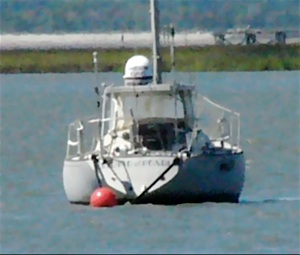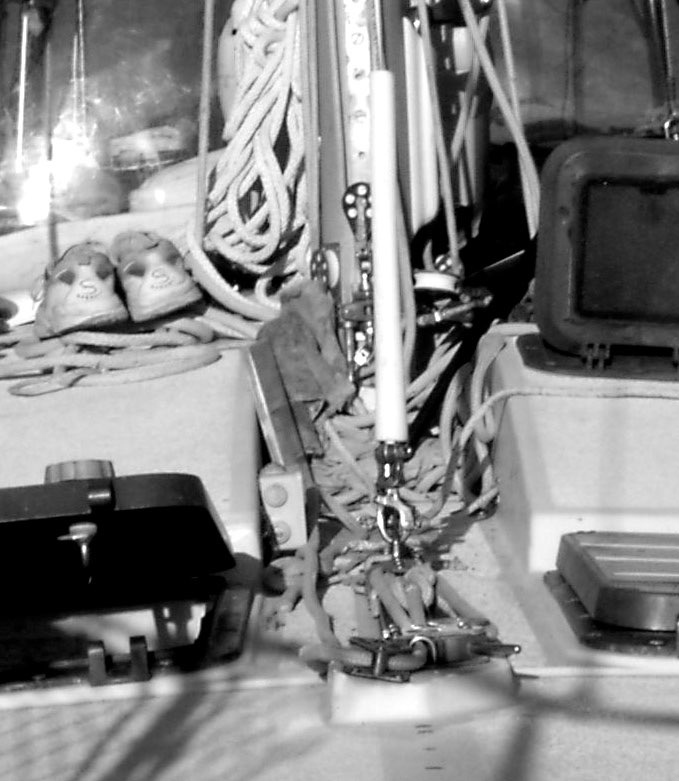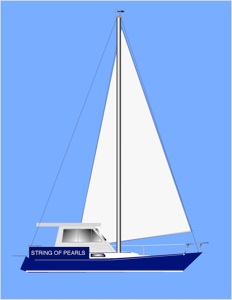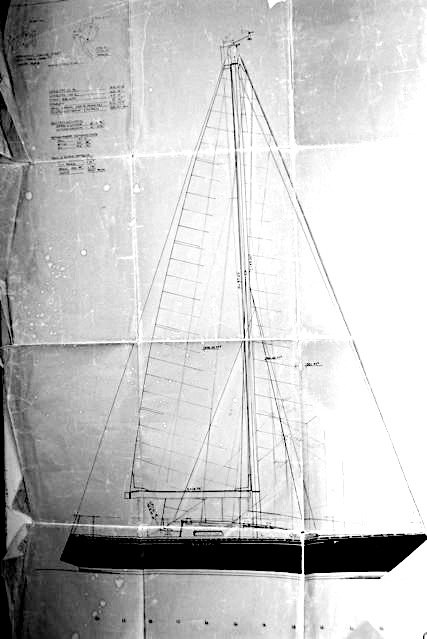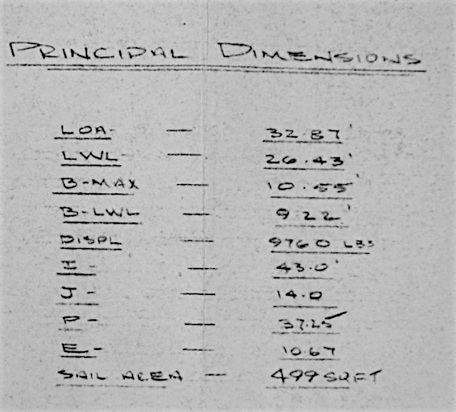Insulated from damp
The boat is insulated from outside cold water and summer sun, so that the inside is always dry even in the lowest areas under the bunks, and the cabin never gets too hot in the tropics. Under the bunks is so dry that I can leave bedding safely stowed there. The home electronics like Computer, VCR, TV and so on never corroded even after several years at sea. The boat was always dry. The only wet that ever gets in is from the drainage of the cockpit seats which I directed into the bilges to be pumped over in order to obviate the need for another through hull for the seat drainage. The cockpit drains into the ocean, of course. I have dozens of books on the boat and they are still nice and dry after many years at sea and at the dock.
Once after a hurricane near miss when we have to evacuate the barrier Islands, I left the boat on a sand bar anchored to two eight foot screws and a long rode to my stern anchor set up. When I got back to the boat there was no moisture in it, and the tea cup I left on the counter was still standing with the tea in it. Several boats had sunk at the docks, or were blown onto the shore. This is the boat at that mooring.
The bulkheads are all glassed both to the floor and to the deck, so nothing moves or creaks. All wood is very high quality teak/mahogany ply of a type you just can’t buy anymore. The layers are thick. Today such wood costs $600 for a sheet of 4’ x 8’ x 1/2” and this boat uses the same teak even in area you can’t see such as the engine room, and the sail bins up fwd.
The keel weighs 4800 lbs., which is half the weight of the boat. It is held up by huge bolts, which pass through reinforced floors made of unidirectional roving. The keel is always tight on the hull and I have never had to fill any gap. The top of the keel is about 6 inches thick, and is well attached to the hull. The swept back shape, like a sharks fin, gives a better lift to drag ratio for upwind work.
Where the mast goes through the deck there is a stiff box section that gives tremendous support for the deck amidships. Straps hold the deck down against the pull of the halyards. There is a baby stay fwd of the mast which counters the tension of the main to help keep it flat. I use the baby stay for a storm jib of 80 square feet which will drive the boat at 6 kts in winds of 25kts apparent.
The sail plan
This sail also has enough power in light wind to move the boat between slips, and it is easy to tack with it. The storm jib can be hank'd on and hoisted from inside the boat, so that in rolling seas I don’t have to go forward on the deck. Under one of the large forward hatches (there are two) is a platform over the head which I can stand on and the deck is then at my waist height, so I can reach around to the halyard and the stay, hank on the jib and hoist it, then hop back into the boat close the hatch and trim the jib from the cockpit.
The biggest genoa is 155%, built this year and designed to be used in winds from 4 - 25 kts apparent without reefing. I haven’t built the house as in this picture—it is just an idea. But the sail is the right size and shape, showing the high tack and large overlap. The high tack is to allow me to see traffic at sea to leeward.
In fact it can’t be reefed. It is hank on, as I hate furlers because they spoil windward performance, and are prone to failure. When I was caught in Hurricane Alma in 1990, I was able to hank on the 110% jib and go to weather for two days solid to get away from the hurricane. My buddy was sailing with a furler on a Rafiki 37 and couldn’t go to weather enough to avoid the winds and the waves swamped the cockpit and tore off his pants as he clung to the Edson steering column for dear life.
After two days of sailing hard on the wind I was able to lay off and sail directly for Hilo in huge seas and winds of 20+ kts, the boat surfing occasionally to 11 kts.
The cockpit was wet all the time because spray came down the weather deck and rolled into the cockpit as there are no cockpit comings. In Hilo I installed some wash boards port and starboard to keep the water on the side decks. Of course, I never had weather that bad again, so they were not really useful, and I eventually removed them as they were a trip hazard.
This is the original sail plan.
These are from the original blueprints of the custom shop.. The genoa 155% is 450 sq ft. The old main added 250 sq ft but that could only be used in winds to 10 kts after that I had to reef the main and at 15 kts change down to a smaller jib. You must understand that the average wind speed in the Ocean is only 8 mph. Once the wind reaches 10 kts all I need is the big genoa. In light winds I fly a chute about 900 sq ft. In the Atlantic trade winds I could hoist the #1 genoa and carry it in all conditions to 25 kts apparent, no furling needed (I have no furler.)
The biggest improvement I made was to get rid of the mainsail. It was the cause of worry in a gale, made the boat heel uncomfortably, was dangerous to reef, and forced headsails changes to balance the reefed main. All recent yachts are designed with big mains and very small jibs. Even cruising designs have bigger mains, because it allows for more room below as the mast is pushed forward of the main cabin. With these designs you can’t dispense with the main.
Many IOR designs from the 70s and 80s have very small mains.
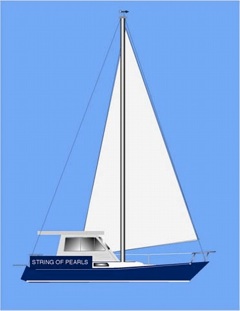
The genoa is twice the main, and you can sail just as fast, if the wind is above 15 kts. If you are in light winds you can switch to a chute or drifter. In the Caribbean the wind is almost always above 15 kts. It is usually 20 kts to windward of the Islands. All you need is a big genoa - I use a 155% genoa. and I don’t have to change sails. You can only make this work if the mast is close to the center of the boat. There must be enough overlap so that the boat will balance which is needed for the wind vane to work. I took off the mainsail in the Pacific, and finally took off the boom in the Caribbean. I have sailed main-less ever since.I don’t like roller reefing/furling. The problem is that you can’t sail well to windward with a partially furled sail. The sail will have too much draft aft, and this causes leeway. When the conditions call for you to go to windward to avoid a danger, a partially furled sail may cause you to fall off towards the danger. My experience is that if you get rid of the main, even a big genoa can be carried wide open through 25 kts apparent, and kept flat with the draft forward (it has to be heavy enough material.) I never have to change headsails except when a gale was coming (34 kts +.) Then I switched down to a storm jib, or a #3. I recently commissioned a new 155% genoa made of heavier cloth, and with the tack 4 feet above the deck, so that I can see traffic to leeward.
If you leave the boat at anchor with the sail furled during a storm, you will probably lose the sail as it unwraps. I have seen a skipper swinging from a bosun’s chair, cutting down the sail which couldn’t be dropped, because the wind was forecast to reach storm force later, and he was worried the sail would completely unfurl and the boat badly damaged.
You can reduce your sail inventory and maintenance to:
Two 155% genoas, a storm foresail, a drifter or chute.





